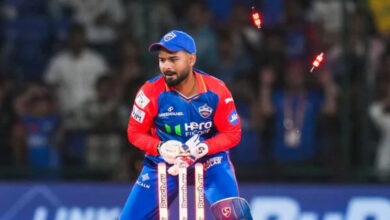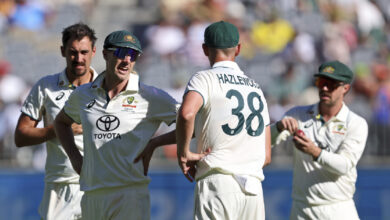Ashwin overtakes Kapil’s tally, but both great in their own right

During the Mohali Test, the broadcast displayed the l of 12 Indians to have played 100 or more Tests, Virat Kohli being the latest entrant to the club. On commentary, former Sri Lanka batsman Russell Arnold told Sunil Gavaskar – another member of the club – that the l included mostly batsmen. The only bowlers on it are Anil Kumble, Kapil Dev, Ishant Sharma and Harbhajan Singh. When the telecast resumed after an ad break, Gavaskar responded saying that he’d just received a text from Kapil Dev. ‘I’m not a bowler, I’m an allrounder.’
On Sunday at the Punjab Cricket Association Stadium, Ravichandran Ashwin went past Kapil’s tally of 434 Test wickets when he dismissed Charith Asalanka in the Sri Lankan follow-on innings. It was the 11th wicket to fall on a day Sri Lanka lost 16 in an innings rout, and the weekend crowd celebrated it amidst India’s inexorable march to victory. As they had celebrated all the Sri Lankan wickets preceding it, and would celebrate all the wickets to follow. One wonders whether some of the fans celebrated Asalanka’s fall more because it had made Ashwin India’s second-highest wicket-taker in Tests, after Kumble.
There was a nice touch as well to where this happened. Kapil had been overtaken about a 15-minute drive away from the ground at which he began his career – the Sector 16 Cricket Stadium in neighbouring Chandigarh that is forever associated with him. It is simply referred to as ‘Sector 16’ local reporters. That much is enough to make the mind flashback to that iconic run-up and leap.
A couple of fitting parallels are attached to when Kapil had gone past Richard Hadlee’s then-record 431 wickets in 1994. Firstly, the feat came in Ahmedabad, where, seven years earlier, Sunil Gavaskar had become the first to score 10,000 Test runs. Secondly, Kapil had also achieved his record with a Sri Lankan wicket – Hashan Tillakaratne – just like Ashwin did.
The Asalanka dismissal was classic Ashwin to a left-hander. Tossed up from round the wicket, drifting in, pitching around off, forcing the batsman to push forward but not quite full enough, thus having the dance to kick away and take the glove off the keeper’s thigh to first slip.
The dismissal to equal Kapil – Pathum Nissanka – had been classic Ashwin to a right-hander. He’d bowled a couple of sharp break-backers to Nissanka, who’d had to scramble to defend and ended up inside-edging. The wicket ball was flighted too, but turned only four degrees compared to the eight on the previous one. changing the angle of the seam and the amount of tweak he imparts on the ball, Ashwin varies the degree of turn. And often, the variation is too much to negotiate for batsmen with the big-turning ball playing on their minds.
According to numbers
Ashwin now has 436 wickets from only 85 Tests, still the fewest matches for a 400-clubber. And his average of 24.26 is next only to Muttiah Muralitharan among spinners in that club. any means, these are astonishing numbers, even more so considering how many injuries Ashwin has had in recent years. As skipper Rohit Sharma said on Saturday, for him, Ashwin is already an all-time great, and there doesn’t seem to be too much reason to disagree.
Kapil’s average of 29.64 and the fact that he took as many as 131 Tests to reach where Ashwin did in 85 might appear to lose some sheen in comparison to the off-spinner. This is not to take anything away from Ashwin, but the plain fact remains that he is an Indian spinner, and Kapil was an Indian fast bowler, that too in an era where bowling fast was a questionable choice for a budding Indian cricketer. As he was famously told upon demanding extra chapatis as a young pacer, there were no fast bowlers in India then.
It is also not unreasonable to state that spinners get wickets in India because of the pitches, and fast bowlers get wickets in India despite them. It is revealing that despite all the advancements in sports science, only one more Indian fast bowler has managed to play 100 Tests after Kapil. And Kapil still has 123 more wickets than Ishant.
On the batting front, Ashwin averages 27.14 to Kapil’s 31.05, so roughly in the same range, and has five centuries as of now against the latter’s eight, which came in 46 more games. Again, this is no disservice to Ashwin, but three of Kapil’s centuries came in South Africa, England and West Indies, when West Indies were at their peak. As solid a batsman as Ashwin is, even a proud competitor like him won’t mind it being said that Kapil was more talented and far more attacking. Just imagine Kapil in the mood in the Indian Premier League.
None of this is meant to make light of Ashwin’s mountainous body of work on a day he has gone past the once-magical 434, and is closing in on 3,000 Test runs. It is only to say that while Kapil may have been overtaken in far fewer games, his value to Indian cricket shouldn’t be judged sheer numbers alone. For although he has phenomenal numbers too, Kapil himself was a phenomenon foremost.







